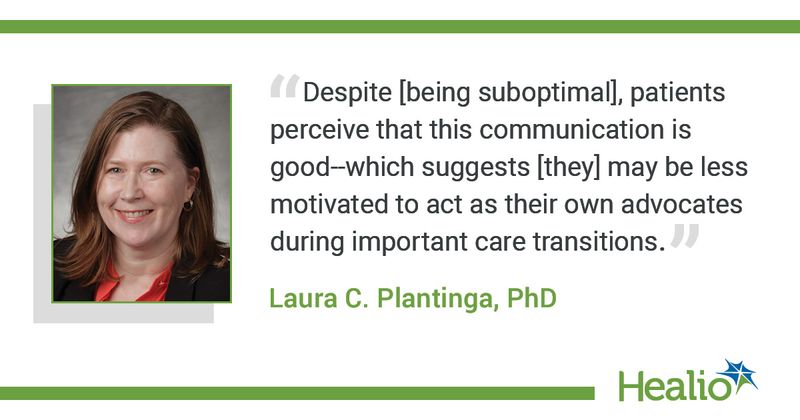Study finds room for improvement in care coordination between dialysis centers, hospitals
Although researchers from Emory University found communication between hospitals and dialysis facilities to be “suboptimal,” patients viewed overall care coordination favorably, according to a study that included a one-time patient survey.
This positive perception was noted despite patients also reporting they were frequently asked to provide the same information to both dialysis providers and hospitals (which, researchers contended, demonstrates a lack of information sharing), as well as patients holding a limited role in their care. Specifically, fewer than half reported bringing hospital discharge instructions to the dialysis clinic after discharge, and one-third “were not interested in a portal to view the communication between hospital and dialysis providers about their care.”

The survey was administered to 113 patients receiving maintenance hemodialysis at Emory Dialysis Clinics who were recently hospitalized at Emory University Hospital Midtown.
“We conducted the overall study to address gaps in care coordination that were likely contributing to the high rates of hospital readmissions and overall high utilization among U.S. patients receiving dialysis,” Laura C. Plantinga, PhD, of Wesley Woods Health Center, Emory Healthcare, told Healio Nephrology. “The primary gap we observed was in inter-setting communication — dialysis clinics complaining that they didn’t know why patients had been hospitalized or how to provide post-acute care, and hospitals complaining that they didn’t know why patients were being sent to the hospital.”
Plantinga said written discharge summaries that clinics and hospitals rely on are often delayed and received after the patient is back at the dialysis clinic, which may lead to errors.
“While this overall study is aimed at improving communication between providers in hospitals and dialysis clinics, we were also interested in how hospitalized patients perceived the coordination of care, which led to the survey reported in our research letter,” Plantinga said.
Patient perception of care coordination
A total of 24 patients responded to the survey, leading to a cohort with an average age of 62 years and a median dialysis vintage of 4 years.
For 91% of respondents, the time between presenting symptom onset and hospitalization was less than a week, with 79% reporting that hospital providers asked about their reason for hospitalization, 75% reporting they had been asked about their dialysis schedule and symptoms, 71% reporting they had been asked about current medications and 50% reporting being asked about their dry weight.
Regarding patient input, only 47% reported bringing their discharge instructions to their next dialysis session, with 67% reporting “they were likely to log into a hypothetical patient version of our web-based platform for hospital care coordination” (compared with 88% who reported they would like a health care surrogate to see this information).
“The take-home message of our research letter is that, despite suboptimal communication between providers in hospitals and dialysis clinics, patients perceive that this communication is good — which suggests that patients and their surrogates may be less motivated to act as their own advocates during these important care transitions,” Plantinga said.
Web-based communications platform for improved coordination
As part of their efforts to improve care coordination between hospitals and clinics, Plantinga and colleagues evaluated the feasibility and effectiveness of a web-based communications platform, known as DialysisConnect; Plantinga noted that results of these analyses will be published soon.
The recently completed DialysisConnect pilot included:
- automatically uploaded information for hospital providers, such as the dialysis patient’s clinic, physician, recent labs and medications;
- short admission and discharge forms for hospital providers to complete for immediate availability to dialysis providers;
- automated messages at hospital admission and discharge to dialysis clinic providers; and
- a channel for providers to communicate across settings, including exchange of documents and acknowledgement of post-discharge orders.
“Generally, the potential benefits of DialysisConnect are that it could close the communications gap between dialysis clinics and hospitals, allowing for appropriate care during and after the hospitalization, which could lead to better outcomes for patients, less frustration for providers and lower costs of care,” Plantinga said.
She said where dialysis clinics are even more isolated, such as in non-academic and rural settings, this may be even more important.
“The primary challenges are: limited provider time and resistance to behavior/process change; less investment in care for patients receiving dialysis among some hospital vs. dialysis clinic providers; and the lack of overlap in hospitals and dialysis clinics (ie, hospitals treat patients from multiple dialysis clinics and dialysis clinics send their patients to multiple hospitals),” Plantinga said.
Next steps include taking what was learned in the DialysisConnect pilot to refine the system and then test it in other settings.
“While DialysisConnect may not be the final answer to improving care coordination between hospitals and dialysis clinics, what we learn from using it can help identify the challenges that could be addressed using other solutions, including the development of EHR-specific systems to facilitate care coordination,” Plantinga said.
